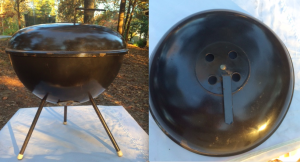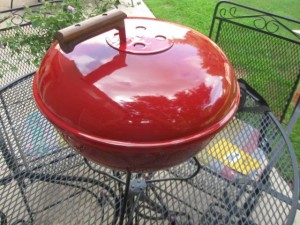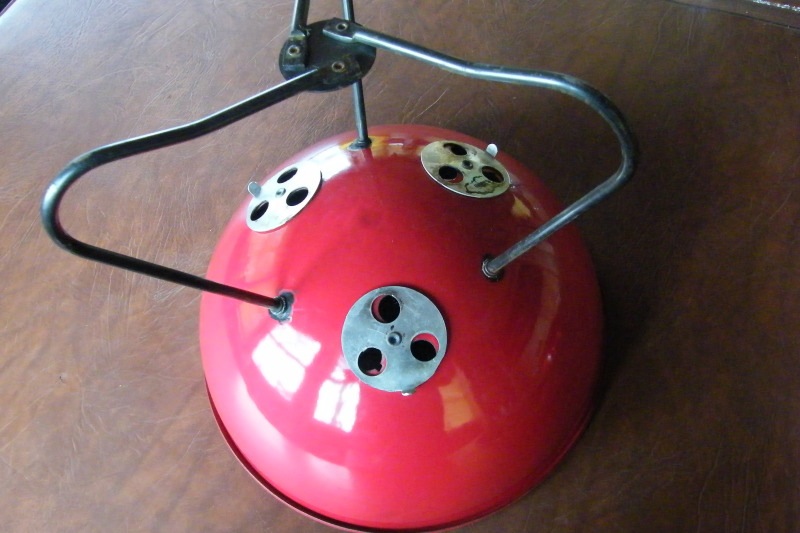The Weber Smokey Joe was first introduced in 1955. Retailing for $12.95, the “New Smokey Joe” was Weber’s first entry into portable, tabletop grills. With a kettle diameter of 14.5 inches, it was small enough to take camping or to the beach, a key feature for Americans that were becoming increasingly mobile. The 1955 model SJ-100 had a offset metal handle, removable tripod legs, and “Flavor Control Features” – marketing speak for the daisy wheel vent in both the bowl and lid. The name “Smokey Joe” is a Weber legend. Apparently, back in the day George Stephen and others from Weber used to hang out in a cozy bar near Chicago. Their favorite bartender was named Joe and the Smokey Joe was named after him.
Below are a couple of pictures of the earliest SJ-100 documented by the WKC to date. Note the metal handle and individual tripod leg system:
The 60’s – The early Smokey Joe’s had an offset handle that was directly attached to the vent. The bowl design consisted of three circular vents. Sometime in the 1960’s the metal handle was replaced with wood and the removable tripod legs were replaced with a couple of new designs:
The three vent bowl design would last until the mid 80’s, while the unique “offset handle” was changed out in the mid 70’s. The offset handle models of the Smokey Joe are highly desired by kettle collectors
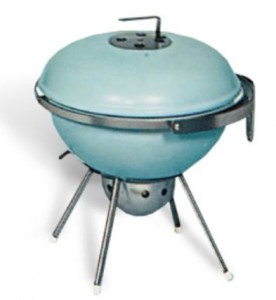 The Smokey Joe Goes To Sea – One interesting variant of the Smokey Joe kettle is a model designed for grilling on a boat. Introduced in 1960, the Galley Que had 4 legs verses 3 for stability on a moving boat. Additionally, this model was Weber’s first-ever enclosed ash catcher for safety. To protect the kettle from corrosion, all of the hardware was done in stainless steel.
The Smokey Joe Goes To Sea – One interesting variant of the Smokey Joe kettle is a model designed for grilling on a boat. Introduced in 1960, the Galley Que had 4 legs verses 3 for stability on a moving boat. Additionally, this model was Weber’s first-ever enclosed ash catcher for safety. To protect the kettle from corrosion, all of the hardware was done in stainless steel.
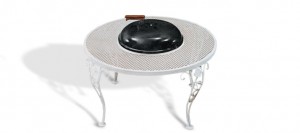 The Original Party Grill – Another derivative of the Smokey Joe is the Weber Flamenco. First introduced in 1963, the kettle in a table was designed with the idea that people could sit around a table and grill hors d’oeuvres or small cuts of meat while enjoying the company of friends. It was an attempt to show consumers a new way to entertain before the main meal was served.
The Original Party Grill – Another derivative of the Smokey Joe is the Weber Flamenco. First introduced in 1963, the kettle in a table was designed with the idea that people could sit around a table and grill hors d’oeuvres or small cuts of meat while enjoying the company of friends. It was an attempt to show consumers a new way to entertain before the main meal was served.
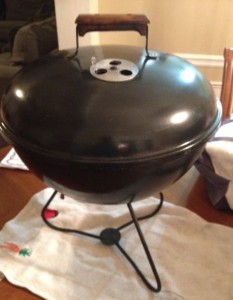 The 70’s – A major design change happened in the mid 1970’s. The handle was no longer attached directly to the vent and instead was attached directly to the kettle lid with two contact points. The vent was moved slightly to one side, just like the 18’5″ Weber kettles.
The 70’s – A major design change happened in the mid 1970’s. The handle was no longer attached directly to the vent and instead was attached directly to the kettle lid with two contact points. The vent was moved slightly to one side, just like the 18’5″ Weber kettles.
Evolution – From the basic SJ-100 model, the Smokey Joe has evolved into a number of variations:
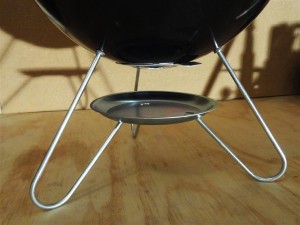 Smokey Joe Silver (SJS) – Introduced in the mid 80’s, the key characteristics of the SJS were a 14.5” kettle size, single daisy wheel bowl vent located at the bottom, and an integrated ash pan that is supported by the legs. This was a major design change; most notably the move from a 3 vent bowl to a single vent. The early SJS had a “loop” design leg style with an integrated ash catcher.
Smokey Joe Silver (SJS) – Introduced in the mid 80’s, the key characteristics of the SJS were a 14.5” kettle size, single daisy wheel bowl vent located at the bottom, and an integrated ash pan that is supported by the legs. This was a major design change; most notably the move from a 3 vent bowl to a single vent. The early SJS had a “loop” design leg style with an integrated ash catcher.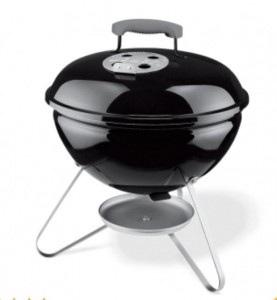
Starting in 1991, the leg style was changed to flat metal stock bolted to the kettle bowl with wing nuts. The integrated ash pan carried over to the new leg design. This style is still in production today.
Smokey Joe Gold (AKA The Outrider) – The SJG was introduced in 1990. Like the Silver model, the Gold was a 14.5” kettle. At first glance this grill looks like quite a bit like the Silver model, however, it is a purpose-built kettle designed for outdoor cooking on camping trips or going to the beach. According to Weber’s US Patent 4,535,749 Portable barbeque grill; “…the need has arisen for a more portable type of unit that can easily be carried about for use on camping trips and other short-term uses where it becomes necessary to assemble and disassemble the unit in a short period of time, and also be capable of transporting the unit small distances while the coals are still burning. In this environment, the surroundings many times make it desirable to accumulate the ashes in the bowl until after the unit has completely cooled to prevent fires when being used in wooded areas.” 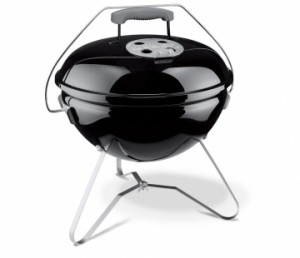 The SJG has a solid bottom bowl to prevent hot coals from spilling and a “Tuck and Carry” locking lid mechanism. The metal bar can be positioned in two ways: 1) on top of the kettle, where it locks the lid to the bowl for easy transport, and 2) positioned horizontally where it acts as a lid holder while the kettle is in use. Ventilation is controlled by two vents located on the side of the kettle where the metal bar meets the bowl. Early on, this kettle was also known as the Outrider, a reference to its intended use in the great outdoors. The Outrider moniker did not last long and the model simple became known as the Smokey Joe Gold.
The SJG has a solid bottom bowl to prevent hot coals from spilling and a “Tuck and Carry” locking lid mechanism. The metal bar can be positioned in two ways: 1) on top of the kettle, where it locks the lid to the bowl for easy transport, and 2) positioned horizontally where it acts as a lid holder while the kettle is in use. Ventilation is controlled by two vents located on the side of the kettle where the metal bar meets the bowl. Early on, this kettle was also known as the Outrider, a reference to its intended use in the great outdoors. The Outrider moniker did not last long and the model simple became known as the Smokey Joe Gold.
Smokey Joe Platinum (AKA Jumbo Joe or Outrider) – Introduced in 1990 and 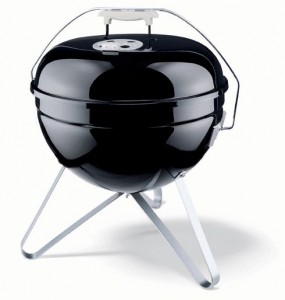 discontinued in 2006, the SJP was an 18.5” version of the SJG. To cope with the larger size and weight of the kettle, it had a different leg design using heavier metal stock. Like the SJG, it had the side ventilation system, solid bottom kettle design, and the tuck and carry system. It was offered in Black, Red, and Green. Like its 14.5″ counterpart, this kettle was also known as the Outrider.
discontinued in 2006, the SJP was an 18.5” version of the SJG. To cope with the larger size and weight of the kettle, it had a different leg design using heavier metal stock. Like the SJG, it had the side ventilation system, solid bottom kettle design, and the tuck and carry system. It was offered in Black, Red, and Green. Like its 14.5″ counterpart, this kettle was also known as the Outrider.
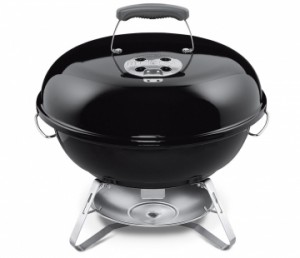 Jumbo Joe (JJ) – After discontinuing the SJP in 2006, Weber brought back an 18.5” portable charcoal kettle named the Jumbo Joe in 2013. The JJ is a hybrid; it has the single vent located at the bottom of the bowl and integrated ash catcher of the SJS, but also has the Tuck and Carry system of the SJG to facilitate portability.
Jumbo Joe (JJ) – After discontinuing the SJP in 2006, Weber brought back an 18.5” portable charcoal kettle named the Jumbo Joe in 2013. The JJ is a hybrid; it has the single vent located at the bottom of the bowl and integrated ash catcher of the SJS, but also has the Tuck and Carry system of the SJG to facilitate portability.
Comparison of SJP and JJ – There is much confusion around the SJP and the modern JJ, especially given that even Weber’s parts diagrams refer to both models as the Jumbo Joe. While both models are an 18.5” variation of the Smokey Joe, there are some key differences. As seen side-by-side, the SJP (left) is taller than the JJ (right). Additionally, note the differences in the ventilation control systems of the two kettles. The SJP has two vents on the side of the bowl which allows air to enter the kettle above the charcoal. The Jumbo Joe, has a daisy wheel located at the bottom of the kettle which flows air directly through the charcoal and up through the top vent:
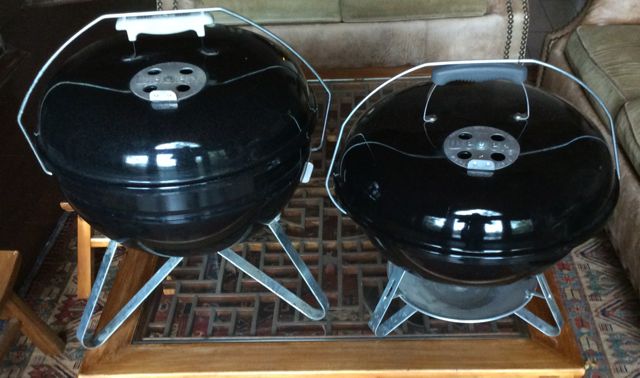
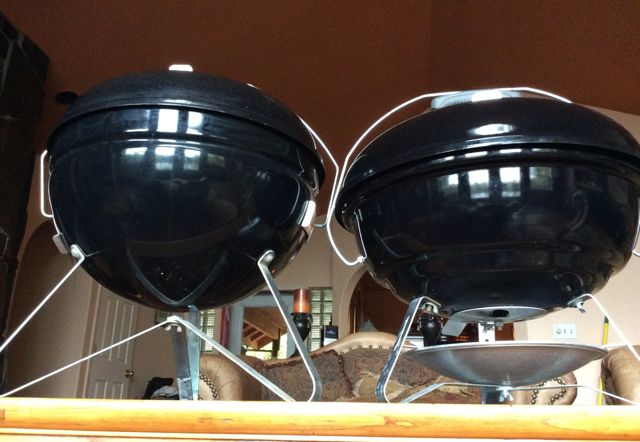
Another key differential between the SJP and the JJ is the slight difference in the size of the grilling grate. The SJP grate measures 17 7/8 inches, while the JJ uses Weber’s standard 17 1/2 inch grate that is interchangeable with their 18.5” one touch grills. Unfortunately, a SJP grate will not properly fit a JJ, and vice versa. The last difference between the SJP and the current JJ is the distance between the charcoal grate and the cooking grate. The SJP measures 5 1/4 inches from grate to grate while the JJ, with its lower profile measures 4 inches. Many feel that the redesigned Jumbo Joe, with its bottom vent and smaller gap between the charcoal and grilling grates, provides much better direct heat for searing meat.
The WKC Smokey Joe Database – In addition to the base models above, several different Smokey Joe colors and themes have been produced over time. Thanks to the contributions of several WKC members, the following is a database of Smokey Joe model numbers and the description of each. You can access the Smokey Joe database here:
The Smokey Joe plays an important part in Weber’s charcoal kettle lineup. The SJ has been around almost from the beginning of the Weber-Stephen company. Throughout its history, it has been the least expensive and most portable Weber charcoal kettle available, and the first one specifically designed for cooking while camping. With a multitude of color options and special editions, there is a Smokey Joe to please just about everyone. If you have historical information about the Smokey Joe model that would add to this article, please send a message to WKC member “Winz”

